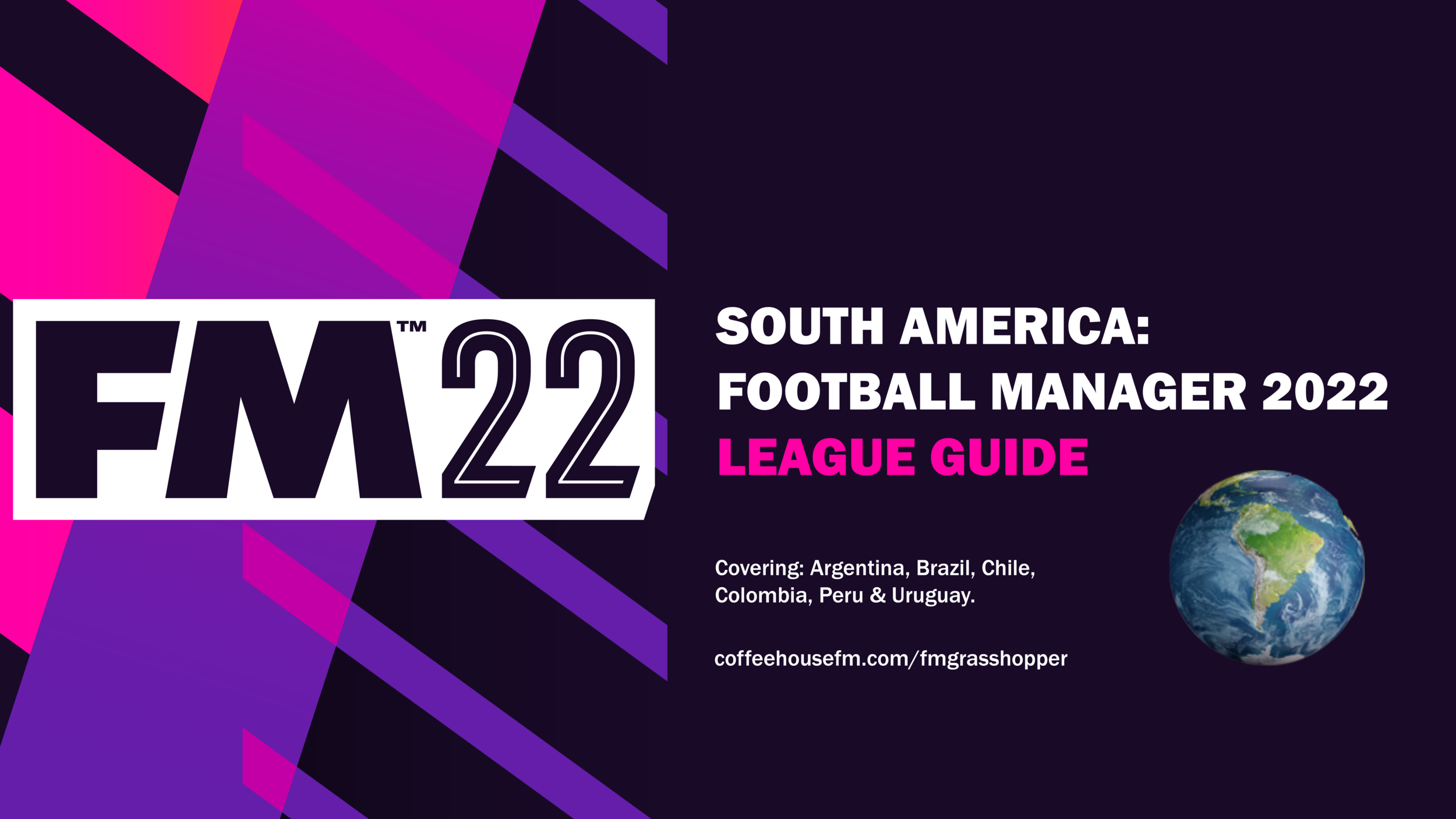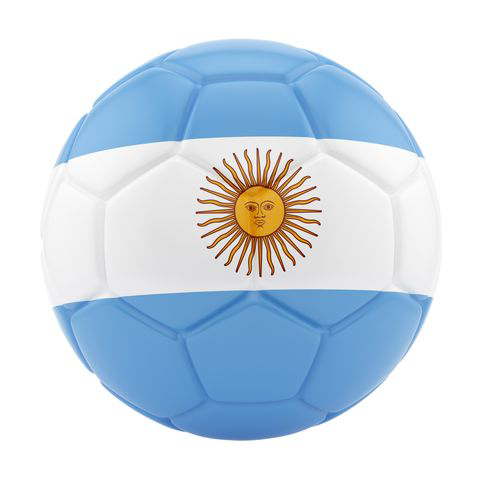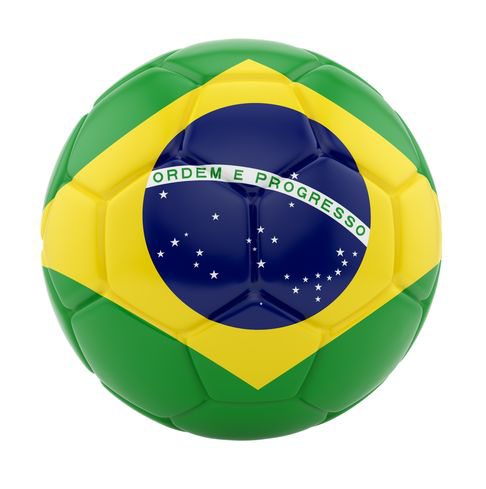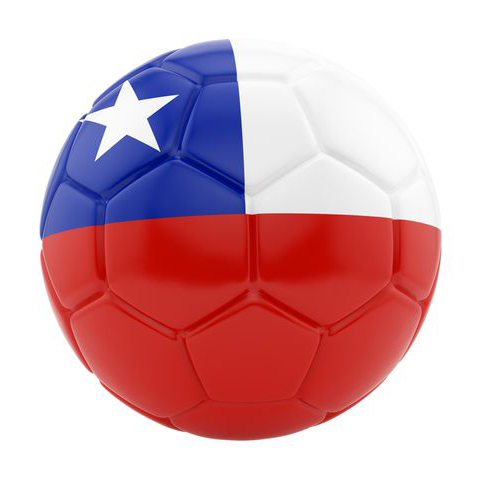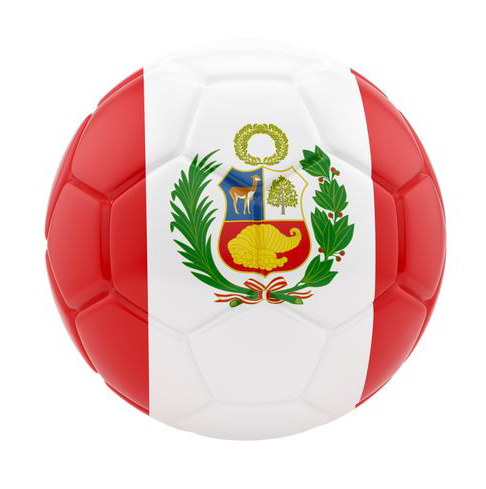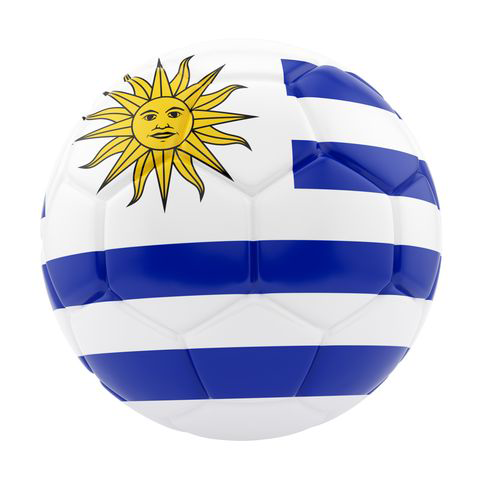Intro
Hello! Just like in previous years, I am back with updated league guide for South American out-of-the-box leagues in Football Manager 2022. After all, the various league systems & continental nuances can be quite unfamiliar to those outside of the continent due to changing rules/regulations between each FM and also year-on-year within the game itself. The previous Covid Pandemic has meant knock-on effects to most leagues in some way or another, and there’s also a December World Cup that disrupts schedules too.
Disclaimer(s): To avoid this becoming War & Peace in length, I have only focused on the top leagues of Argentina, Brazil, Chile, Colombia, Peru & Uruguay. Additionally, I have only chosen these nations because they are leagues that are in Football Manager 2022, which do not need any database edits for players to manage in. It is also worth noting that this is for Football Manager 2022, and more specifically from the 2022 calendar year onwards. A lot of the information can probably be used in later editions of the game, but year-on-year changes are expected which have yet to be determined at the time of writing.
If you like this post, or think it will be useful to others, please share via the link at the bottom of this page. The aim of this post has always been to tackle the “I don't know enough about South American football, which means I won’t go there” attitude towards some of the most fun leagues in Football Manager. Even if this post helps just one person in FM22, then it’s been worthwhile.
Argentina
A 2021 Copa América title win for Argentina ended an eight year wait for a trophy (since the 2008 Olympic triumph). The demons exorcised by Ángel Di María’s 1st half goal against home favourites Brazil mirrored the jubilant scenes back during that Olympic win, when once again Di María’s solitary goal proved the difference against Nigeria. 1-0 Argentina. History has a way of repeating itself.
But is the country at the summit of its powers? No, far from it. Beneath the European stars heading up the European Super League clubs there is a domestic game that has been hit hard by the pandemic. Clubs are poor, and the young starlets do not last long before being sold north to Major League Soccer/Mexico or east to Europe. However, the production line of talent never ends, history again reminding us that it likes to repeat itself: Di Stéfano, Bochini, Kempes, Maradona, Batistuta, Riquelme and Messi…every generation has an idol. It’s probably time you headed to this league to create the new one, right?
This has been updated based on FM22’s 22.3.0 Winter Patch…
Number of clubs in top league:
Argentina has a unique system that changes year-on-year, as the number of teams in the top tier fluctuates. Argentina will keep you on your toes until 2026 where the restructuring stops and sees players end up with a 20 team/38 game season league. The best way to think of Argentina for the initial two years in FM22, is a cup competition for the first half of the calendar year (Copa de la Liga), whereby teams are split into two groups based on the previous 6 months performance in the Primera División or promoted teams via the Primera Nacional. Then a more traditional league where you will face each side in one table.
However, the Copa de la Liga format only exists for two years in FM22 (2021 & 2022). For the 2023 year, players will get a one-season 26 team Primera División that starts in March before splitting into Championship and Relegation groups running from August to December. Both with 13 teams. From 2024, a more traditional system exists with 24 teams/46 game league. This drops down in each of the next two years (2025 and 2026) until we finally end up with the fabled 20 team league, playing each other twice (38 game season) where no more changes will occur!
League calendar: For 2021/22: 25 matches per regular Premier Division season (July-December). Then Copa de la Liga from February-May, where the league is split into two groups, with the top four in each progressing to a Quarter Final Stage. QF and SF ties are two legged, with penalties deciding if teams are level after 90 minutes. Final is single legged at a neutral venue.
As expected, the 2022 World Cup causes a bit of upheaval to the league calendar. There will be limited rest between both Copa de la Liga and Primera División tournaments, as the league looks to conclude two months early in October 2022.
Note - the 2022 Copa de la Liga will feature 28 teams (to include two teams being promoted from the 2nd tier). If you start a save earlier (pre-May 2021), you will have a 26 team Cope de la Liga. Winning the Copa de la Liga grants access to the Copa Libertadores Group Stage and also to the end of season Trofeo de Campeones Vs the Primera División winner (only played in the first two seasons).
Transfer windows & restrictions: (1) 01 July to 05 August 2021 (foreign signings can still be announced until 16 August 2021), (2) 07 December 2021 to 20 January 2022. Maximum of 6 foreign players.
Continental qualification: Copa Libertadores Group Stage (1st-4th), Copa Libertadores Qualifying (5th) and Copa Sudamericana (5th-9th) from the Overall Table. Copa de la Liga gets Copa Libertadores and Runner Up gets Copa Sudamericana in 2021 and 2022. Copa Argentina Winner gets Copa Libertadores. Note - it’s worth noting that this is qualification is usually for the following year, depending on what you win and when in Argentina :-)
Club Recommendations: Platense (Hard), Colón de Santa Fe (Medium) and Lanús (Easy).
Brazil
On 26 November 2021, Palmeiras will face Flamengo in the third straight all-Brazilian Copa Libertadores Final. Continentally speaking, Brazil is starting to dominate and the Covid Pandemic seems to have exacerbated the gap between Brazil and everybody else even further. The Brazilian league is the richest in South America, and you will be able to cherry pick the best talents in the Continent to join you. So, where is the challenge?
Well, in Brazil you will find a gruelling all-year-round domestic calendar with national and state championships to ensure you will never get bored. The challenge here will be to rotate and manage your squad, because the Serie A league is competitive. It will take a good (and dedicated) Football Manager player to last the distance…
Number of clubs in top league: 20
League calendar: 38 matches per regular Serie A season (April-December), then an additional 10+ games within state leagues (January-April), Copa do Brasil runs from (February-September).
Note - A bonus 4th domestic competition is possible if you choose a club from the West (Copa Verde - running July-October) or North East (Copa do Nordeste - running January-May).
Important: The regular 20 club Serie A campaign is similar to European Leagues; each side plays one another home and away and this decides both continental qualification and relegation. However it's the state leagues that make Brazil standout as a unique challenge in Football Manager 2022.
Due to economic and geographic problems within a country as vast as Brazil, both clubs and fans have placed great importance on state based football. Each of Brazil's 26 states has its own league that will run in the first quarter of the year. You will play your geographical rivals and although it’s a chance to rotate your squad (with the national league and continental competitions in mind), there will still be an expectation to perform in the big derby games.
Transfer windows & restrictions: (1) 01 January to 24 September 2021 (domestic transfers only), (2) 01 March to 23 May 2022 (foreign transfers only) and 01 August to 23 May 2022 (foreign transfers only). Maximum of 5 foreign players in the match day squad.
Continental qualification: Copa Libertadores Group Stage (Positions 1st-4th in Serie A + Winner of Copa do Brasil), Copa Libertadores Qualifying (5th & 6th) and Copa Sudamericana (7th to 12th). Note - from Serie A, not the state leagues.
Club Recommendations: Grêmio (Hard), RB Bragantino (Medium) and Atlético Mineiro (Easy).
Chile
I always recommend Chile to people that have never tried South America. Mainly because it’s a smaller league where everybody plays each other twice, and the winner of the league is the champion. It’s as close to the European way of accepting champions as it gets. However, the Covid Pandemic obviously disrupted the orderly pattern with the ANFP (Asociación Nacional de Fútbol Profesional) deciding that Chile’s top league will include extra promoted teams to make up for previously cancelled tournaments. Therefore, the remnants of this are felt in the first season of FM22 if you select the 2021 start year, where we see Chile’s top league made up of 17 teams with an extra team relegated in 2021 in order to get back to the pre-pandemic number of a 16 team campaign from 2022.
Number of clubs in top league: 16 (from 2022)
League calendar: 30 matches in the 2022 season (February to November) containing 16 teams. Two teams relegated in 2022, the bottom team and one of 14th and 15th after a two-legged relegation playoff. There is no average points in Chile. Plus a Copa Chile cup competition that has two-legged ties running from April to November.
Transfer windows & restrictions: (1) 31 December 2021 to 13 February 2022 and (2) 04 June to 19 July 2022 (maximum of 3 players). Maximum of 7 foreign players (only five over-21 years).
Continental qualification: Copa Libertadores Group Stage (1st & 2nd), Copa Libertadores Qualifying (3rd & winner of Copa Chile) and Copa Sudamericana (4th, 5th, 6th & 7th).
Club Recommendations: Santiago Wanderers (Hard), Audax Italiano (Medium) and Union La Calera (Easy).
Colombia
Football is often seen as a distraction away from the day-to-day struggles of real-life, but even for Colombians this has been hard to do over 2021. The Government’s planned tax reform, in part to prop up and boost the country’s economy after the pandemic, has led to many months of violent protests. Violence I should say led directly by the armed riot police…who used live ammunition over tear gas on protesters, who used brutality over discourse; football rightly came secondary to the tragedy unfolding. In May 2021, Colombia was removed as co-host for the 2021 Copa América amid the ongoing protests. Colombia should have been celebrating its rich and entertaining football with its neighbours, instead the violence rumbled on.
Despite this, Colombian football continued in 2021. A domestic league that follows an Apetura/Clausura format over the course of a calendar year, which has the unique angle of crowning two league champions a season with an additional gameweek dedicated to a fixture against a local rival. It’s where I spent my enjoyable time in FM21, is it now your turn to experience the 70-80 game a season format for FM22?
Number of clubs in top league: 20
League calendar: 20 game Apertura (January-May) followed by a 6 game Apertura-Quadrangular (June) & 20 game Clausura (July-November) followed by a 6 game Clausura-Quadrangular (November-December). Copa Colombia cup competition also runs throughout most of the year (February-November). Note - domestic football in 2022 is curtailed for the FIFA World Cup in Qatar at early November, leagues are condensed slightly.
Important: Colombia has a classic South American Opening & Closing system, whereby the league campaign is split into two halves. After each half (Apertura & Clausura), the top eight teams are separated into two groups of four who will play one another twice home/away (the top 2 teams from Apertura and Clausura will be separated, but the other 6 teams are drawn into each group). The winner of each group (Quadrangular) will then play one another (again home/away) to see who is crowned league winner. This means there will be two league champions each year.
From there, the winner from each or the Apertura & the Clausura will go on to play in a grand final (known in FM as the Colombian Super Cup). These two legged ties are played mid-late January and can almost be seen as the following season’s opener (think: English Community Shield). Some teams will still count this as a trophy and place more importance to it, but it is acknowledged that there are two league winners every year from the Apertura/Clausura-Quadrangular (rather than one overall winner).
Note - the additional 20th match is a reverse home/away fixture with a local rival.
Transfer windows & restrictions: (1) 01 January to 06 February 2022 and (2) 01 July to 07 August 2022. Maximum of 4 foreign players (only 3 in the starting XI).
Continental qualification: Copa Libertadores Group Stage (Winner of the Apertura Quadrangular & Clausura-Quadrangular), Copa Libertadores Qualifying (Winner of Copa Colombia and next best place team in the annual aggregate table). Copa Sudamericana (the four best teams in the annual aggregate table that did not qualify for the Copa Libertadores).
Note - Winning the 2020 Copa Colombia resulted in direct qualification to the 2021 Copa Libertadores Group Stages. However, this has been amended slightly to only grant a Copa Libertadores qualifying spot in FM22. So, Libertadores Group Stage qualification reverts back to Apertura-Quadrangular and Clausura-Quadrangular winners.
Club Recommendations: Once Caldas (Hard), Deportes Tolima (Medium) and América de Cali (Easy).
Peru
Like other Andean mountain nations, many Peruvian clubs have the added advantage of altitude when foreign opponents come to play. This is particularly needed since Peru is probably the weakest (and poorest) South American nation in Football Manager 2022, you will need shrewd management to be a success here. But there is a unique league system and a Bicentenaro cup between the two league divisions, meaning there are many surprises in Peru. One of my favourites being the unique added points for Reserve League Winners and Runners Up that could impact on the points tally for your First Team. It could be the difference in a title challenge or a relegation dogfight, it pays to keep close attention to what your reserves do! Please note - Peruvian domestic football changes annually, so the below is documented to the best of my knowledge but is subject to change.
Number of clubs in top league: 18 in 2022 (with two relegations).
League calendar: Two domestic tournaments (34 games in 2022 and then 30 games in 2023) before a playoff to decide national champion (Apertura winner Vs Clausura winner). Copa Bicentenaro - a recently launched domestic cup competition played between the two top leagues in Peru. Ties are played June to August between Apertura and Clausura.
(1) Apertura (Opening) from March to May. Two groups of 9 playing one another once. Before a single legged final of the two group winners to decide the Apertura winner.
(2) Clausura (Closing) from August to December. 18 teams playing each other once. 1st place is Clausura winner, a playoff is arranged if teams finish with the same record.
(3) Championship Playoff in December. The least likely scenario sees four teams contest to decide who is the national champion: winners of both the Apertura and Clausura plus the two leading teams in the aggregate table play a two-legged semi-final (home and away). Each time, the side with the most points in the aggregate table will choose the order of their home leg. No away goal ruling in the final, so in the event of the stalemate the tie will be decided in extra time or penalties.
However, what’s more likely to happen is one of the winners of the Apertura and Clausura being in the top two from the overall table. This team would go straight into the final…meaning there would be just one semi final. Alternatively, there is a scenario where the Playoff goes straight to a final, with both the Apertura and Clausura winners topping the Overall Table.
Lastly, there is a scenario where no Playoff is played. Where one team wins both Apertura and Clausura and is therefore automatically crowned the annual domestic Peruvian champion.
Note - 1st place in Overall Table in Reserves league earns their main team two extra points, 2nd Reserve league finishes earn one point. So, keep an eye on your Reserves as the season progresses. The aggregate table (Overall Table in FM22) will include both the Apertura group stage and Clausura match results - excluding Apertura final.
Important: Relegation is decided via the annual aggregate table, with two sides going down. There is also the possibility of a 16th Position Playoff, should teams draw on points tally via the aggregate table (as Goal Difference is not used to decide relegation).
Points deduction are likely if teams cannot grant 810 minutes to sub-20 players over a rolling eight game period. To be on the safe side, it’s best practice to have a couple of players under 20-years-old in your starting XI.
Note - The Copa Bicentenario has changed once again. It’s now a traditional knockout cup competition with five rounds between June and August (single legged ties). The winner will be granted entry into the Copa Sudamericana.
Transfer windows & restrictions: (1) 07 January to 29 March 2022 and (2) 13 June to 12 July 2022. Maximum of 5 foreign players.
Continental qualification: Copa Libertadores Group Stage (Top two teams in the annual aggregate table), Copa Libertadores Qualifying (3rd & 4th in the annual aggregate table) and Copa Sudamericana (5th, 6th, & 7th in annual aggregate table and the winner of the Copa Bicentenario).
Club Recommendations: Academia Cantolao (Hard), Universidad César Vallejo (Medium) and Alianza Lima (Easy).
Uruguay
The Uruguayan system of Apertura/Clausura with a Intermedio mid-season tournament sandwiched in between is my favourite South American league system in Football Manager. I think the smaller/intimate league is appealing and you can certainly use that middle tournament to rotate youth prospects, as the prestige lies elsewhere in the traditional leagues on either side of it. Uruguay has a single domestic champion each year and all the good work of a league campaign can come undone in that grand finale.
The country is also notorious for developing warriors with guile, and every generation has its heroes: Enzo Francescoli of the 80s, Álvaro Recoba of the 90s, Diego Forlan of the 00s and present day Luis Suárez. Can you develop the next World Class Uruguayan for the 2020s?
Number of clubs in top league: 16
League calendar: Three domestic tournaments (37 games and possible +2 games extra for finals):
(1) Apertura (Opening) from January to April. Sixteen teams playing each other once.
(2) Intermediate (mid-season tournament) from July to August. Sixteen teams split into two groups of eight - those finishing in odd positions in Apertura in one group and evens the other. The group winners play each other in a one-legged final to determine the mid-season Champion.
(3) Clausura (Closing) from August to November. 16 teams playing each other once (with home and away switched from the Apertura)
Important: despite there being three separate tournaments, there is an overall table of which points from all three tournaments are collated. The reason is that the overall table has a say in who gets to be crowned the Uruguayan Grand Champion (see below) for that calendar year and also decides who gets relegated.
Grand Champion: the winner of both the Apertura and Clausura play one another in a Semi Final*. The winner plays the team in 1st place of the overall table in a Grand Final. There are occurrences where either the Semi or Grand Final never happen, e.g. a Semi Final winner topping the overall table meaning no Grand Final OR a club winning both Apertura & Clausura AND heading up the overall table, meaning no Semi Final.
*There is even the rare possibility of a Position Playoff in either the Apertura and Clausura if two teams finish on the same points. This would be played prior to the Semi Final.
Relegation: Bottom 3 teams in the average table go down.
Transfer windows & restrictions: (1) 11 June-20 July 2022 and (2) 01 January-02 February 2023. Note - Free Transfers are unlimited and can be signed any time. Maximum of five players on loan at any one time. Maximum of 6 foreign players.
Continental qualification: Copa Libertadores Group Stage (1st & 2nd), Copa Libertadores Qualifying (3rd & 4th) and Copa Sudamericana (5th, 6th, 7th & 8th). Note - from overall table.
Club Recommendations: Centro Atlético Fénix (Hard), Liverpool de Montevideo (Medium) and Montevideo City Torque (Easy).
Continental Competitions
Estadio Monumental Banco Pichincha will host the 2022 Copa Libertadores Final.
Whichever nation you choose to manage in, the spectacles of the CONMEBOL Libertadores and Sudamericana tournaments are offered to all. Specific details as follows:
Copa Libertadores - South America's most reputable trophy, which runs throughout the calendar year (January to November). 47 teams participate in three stages: Qualifying, Group Stage and Knockouts. Knockouts are two-legged home & away ties with away goals…until you get to the final, which is played as one tie at a neutral venue (the 2022 final will be in the Estadio Monumental Banco Pichincha, Guayaquil, Ecuador).
Winning the Copa Libertadores will mean you qualify for it once again. The winner will also enter the FIFA Club World Cup & the Recopa during the next calendar year (see entry below).
Copa Sudamericana - South America's second continental competition, which also runs throughout the calendar year (March to November). 44 teams enter in at various stages to a knockout competition. Games are two-legged home & away ties with away goals…until you get to the final, which is played as one tie at a neutral venue (the 2022 final will be in the Estádio Nacional Mané Garrincha, Brasília, Brazil). The winner will qualify for the subsequent Copa Libertadores campaign and also enter the Recopa (see below).
Recopa Sudamericana - This is the South American Super Cup: winners of both the Libertadores and the Sudamericana face-off against one another over two legs home & away. Ties are usually played in the South American mid-Winter (May). If tied on aggregate, the away goals rule would not be used, and 30 minutes of extra time would be played. If still tied after extra time, a penalty shoot-out is used to determine the winner.
Although not as prestigious as the Copa Libertadores, clubs and fans will still place a great deal of importance on winning this trophy. In my opinion, the move towards neutral venues in both the Copa Libertadores and Sudamericana may also heighten the excitement for the annual Recopa tournaments. As it would give more fans the chance to once again see their clubs win continental honours live in their own stadium (something the Libertadores & Sudamericana have recently ditched).
I hope you found this guide useful, and you enjoy Football Manager 2022 on the South American continent!
Tony / FM Grasshopper

